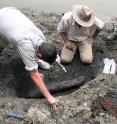13-million-year-old 'storyteller' crocodylian fossils show evidence for parallel evolution
The 13-million-year-old fossils of an extinct crocodylian, named 'the storyteller,' suggest that South American and Indian species evolved separately to acquire protruding, 'telescoped' eyes for river-dwelling, according to a study published April 20, 2016 in the open-access journal PLOS ONE by Rodolfo Salas-Gismondi from the University de Montpellier, France, and colleagues. The gavialoids are a diversified group of mostly extinct long-snouted crocodylian species. Many of the evolutionary relationships between these species remain unclear; fossils of extinct gavialoids from South America and the extant Indian gharial gavialoid have similar telescoped eyes, but it was not known how these features evolved.
The authors of the present study examined Peruvian fossils from a 13-million-year-old South American species, the oldest known gavialoid crocodylian from the Amazon, which they named Gryposuchus pachakamue after Pachakamue, a pre-Hispanic South American 'storyteller' god thought to have knowledge about the origins of South American life. The fossils were dated as Middle Miocene and came from the Pebas Formation, which was likely made up of swampy waterways, suggesting that the crocodylian had a river-dwelling lifestyle. It had only slightly telescoped eyes. The researchers conducted phylogenetic and morphometric analysis to assess the likely evolutionary development of the protruding telescoped eyes of Indian and South American species.
Their analysis suggested that the 'storyteller' crocodylian with slightly telescoped eyes represents the ancestral condition from which the South American lineage evolved telescoped eyes. The eyes therefore evolved in parallel in South American and Indian lineages, at first showing partial telescoping as in the 'storyteller' crocodylian, and eventually becoming fully telescoped as seen in later-evolving species. Both South American and Indian species adopted a river-dwelling lifestyle, and it is likely that telescoped eyes were adaptive, helping them to catch fish in these habitats.
Although further research is needed, thibs study may further our understanding of both the 'storyteller' crocodylian and the evolution of all gavialoid crocodylians.
Source: PLOS
Articles on the same topic
- Discovery of 13-million-year-old croc suggests parallel evolution of 'telescoping' eyesThu, 21 Apr 2016, 20:35:30 UTC
Other sources
- 13-Million-Year-Old 'Storyteller' Crocodylian Fossils Show Evidence for Parallel Evolutionfrom Newswise - ScinewsThu, 21 Apr 2016, 20:30:43 UTC
- 13-million-year-old 'storyteller' crocodylian fossils show evidence for parallel evolutionfrom Science DailyWed, 20 Apr 2016, 20:30:45 UTC
- 13-million-year-old 'storyteller' crocodylian fossils show evidence for parallel evolutionfrom PhysorgWed, 20 Apr 2016, 18:00:53 UTC

![Time calibrated phylogenetic tree of the <i>Gavialoidea</i> and relevant paleogeographic distributions associated with the evolution and diversification of gavialoids in marine and freshwater settings.
During the Late Paleocene-Early Eocene interval, peaks of sea surface temperature (SST) and global sea surface level (GSL) occurred together with tropical marine connections through the Tethys Ocean and Caribbean Sea [59,60]. During the Neogene, distinct biomes dominated tropical South America: (A) Acre Phase, after the onset of the eastern-draining Amazon and northward-draining Orinoco river systems; and (B) Pebas Mega-Wetland System, with its drainage northward to the Caribbean Sea.
Abbreviations: Olig., Oligocene; Ple., Pleistocene; Pli., Pliocene. Global and South American schematic paleogeography adapted from Blakey [60] and Hoorn <i>et al</i>. [61], respectively. Time calibrated phylogenetic tree of the <i>Gavialoidea</i> and relevant paleogeographic distributions associated with the evolution and diversification of gavialoids in marine and freshwater settings.
During the Late Paleocene-Early Eocene interval, peaks of sea surface temperature (SST) and global sea surface level (GSL) occurred together with tropical marine connections through the Tethys Ocean and Caribbean Sea [59,60]. During the Neogene, distinct biomes dominated tropical South America: (A) Acre Phase, after the onset of the eastern-draining Amazon and northward-draining Orinoco river systems; and (B) Pebas Mega-Wetland System, with its drainage northward to the Caribbean Sea.
Abbreviations: Olig., Oligocene; Ple., Pleistocene; Pli., Pliocene. Global and South American schematic paleogeography adapted from Blakey [60] and Hoorn <i>et al</i>. [61], respectively.](http://esciencenews.com/files/imagecache/image_medium/images/2016042112495171.jpg)